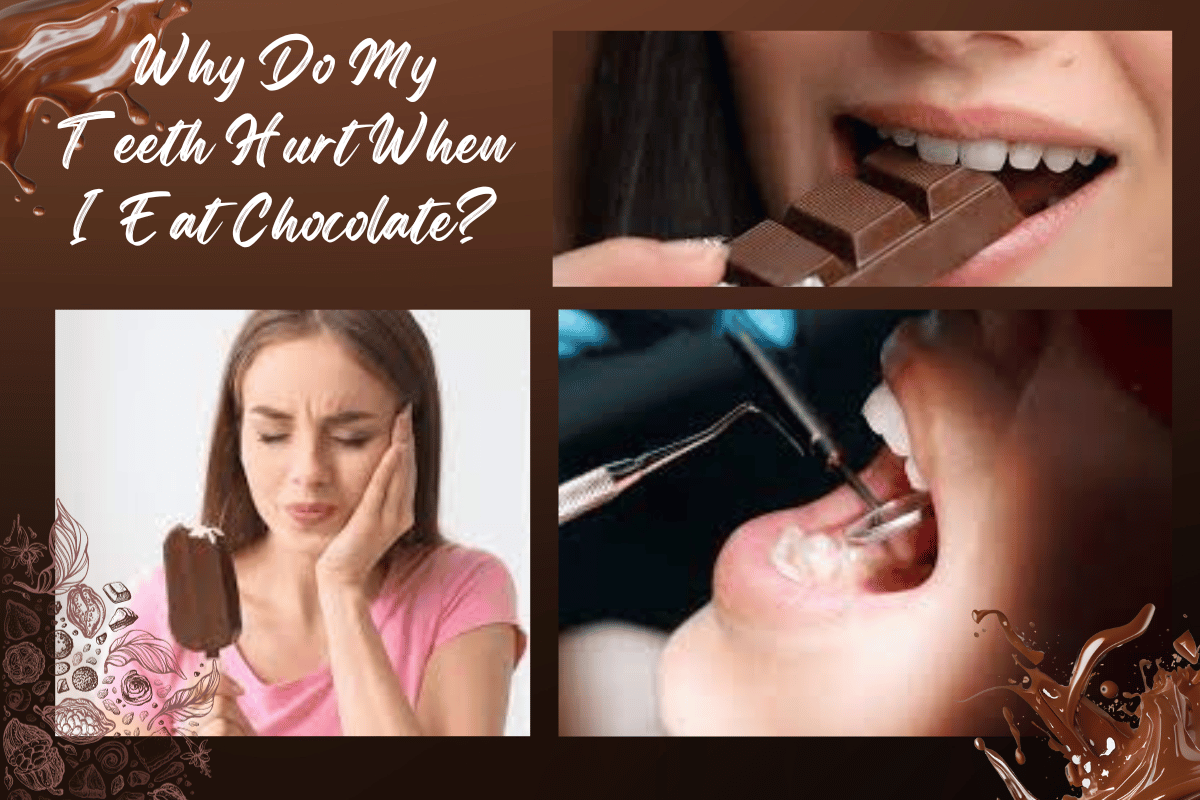Only to be met with searing pain in your teeth as you chew? It’s an experience no one ever hopes for, but why does it happen in the first place? The truth is that when we eat chocolate, we are giving our teeth a dose of sugar and acid that can lead to painful sensitivity.
Too much sugar and acid can cause erosion on the enamel of our teeth, which can lead to soreness through exposure to calcium ions in other foods. Each bite of sweet bliss could thus slowly be stripping away the protective layers of our teeth, leaving us susceptible to greater discomfort.
KEY Points Why Do My Teeth Hurt When I Eat Chocolate?
- Excessive consumption of sugar and acid in chocolate can erode the tooth enamel, causing sensitivity.
- Chocolate’s natural sugars and citric acid may lead to tooth decay when consumed in large amounts.
- Tooth pain from eating chocolate can be due to sensitivity, high sugar content, chemicals, or existing oral health issues.
- To prevent tooth damage from chocolate, it’s crucial to practice moderation, brush and floss regularly, and use toothpaste for sensitivity.
- Additionally, one should avoid sugary drinks and gummy foods, and consider opting for dark chocolate with less sugar and natural citric acid.
How to define chocolate?
Chocolate is a beloved sweet treat made from the seeds of cocoa trees. It has been enjoyed for centuries as an indulgent snack with surprising health benefits. Some people may, however, experience pain in their teeth when they eat chocolate. The main ingredient in chocolate is cocoa butter, which is composed of fat and carbohydrates.
This saturated fat can be hard for teeth to process, meaning that when you bite into a piece of chocolate, the cocoa butter may stick to your teeth. The secret lies in its favorite treat status among people worldwide, offering a sweet, creamy taste to satisfy any craving. It’s an indulgent treat to enjoy in moderation. But, why do some people experience tooth pain when they eat it? Let’s explore the answer.
Tooth Pain Causes When Eating Chocolate
Eating chocolate can be a truly enjoyable experience, but for some people, it may cause an unexpected sensation: tooth pain. This issue is often caused by the different textures and temperatures of chocolates compared to other foods. To help understand why your teeth hurt when you eat chocolate, let’s take a look at some of the underlying causes.
Temperature and Texture Sensitivity
One of the common reasons for tooth pain after eating chocolate is sensitivity to temperature and texture. Chocolate has a much softer texture than many other foods, making teeth more sensitive when biting into it. Additionally, chocolates are often served chilled or frozen, leading to sudden changes in temperature that can cause pain.
Sugar Content in Chocolate
Many types of chocolates are high in sugar, which can cause tooth pain when eaten. Sugar is known to feed bacteria and plaque on the teeth, leading to tooth decay and other issues that cause pain. Eating too much chocolate with a high sugar content may, therefore, aggravate or even create oral health problems.
Chemical Compounds in Chocolate
Chocolate may contain chemical compounds that can irritate sensitive teeth, such as theobromine. This compound is known to create a mild numbing sensation when ingested, potentially causing pain in people with especially sensitive teeth. Additionally, some chocolate manufacturers use ingredients like menthol or cinnamon that can increase tooth sensitivity.
Impact of Chocolate on Existing Oral Health Conditions
If you already have pre-existing oral health issues, eating chocolate can lead to additional discomfort. Conditions such as tooth decay and gum disease can be made worse by the sugar content of chocolates, leading to further irritation and pain when eating. Additionally, those with sensitive teeth may suffer from increased sensitivity after eating chocolate. Tooth pain when eating chocolate can have a number of causes, ranging from the chemical compounds and sugar content in chocolates to pre-existing oral health conditions. Taking proper care of your teeth can help reduce tooth pain when enjoying your favorite treats.
Understanding the Composition of Sugar and Acid in Chocolate
The composition of sugar and acid in chocolate can pose a challenge for your teeth. Chocolate contains natural sugars like sucrose and fructose, along with naturally occurring citric acid. These ingredients can cause tooth decay when regularly consumed in large quantities, leading to soreness and pain in the teeth. Eating gummy or sticky sweets such as chocolate bars also increases the risk of gum disease and cavities. It’s crucial to be mindful of the impact of the sugar and acid composition in chocolate on your oral health and consider moderation in your consumption for the sake of healthier teeth.
Understanding the Impact of Sugar on Teeth Health
Consuming sugary foods and drinks can have detrimental effects on your oral health. When eaten in excess, these items can lead to tooth decay. This is particularly true for eating chocolate with high amounts of sugar, as the sugars can quickly break down and enter the enamel, causing it to weaken over time. The result can be a range of oral issues, including tooth pain, sensitivity, and discoloration. Additionally, the consumption of sugar increases the risk of developing gum disease, which can, in turn, lead to further oral health problems. It’s crucial to be mindful of your sugar intake for the sake of a healthy smile.
Preserving Your Smile: Tips for Enjoying Chocolate without Tooth Damage
If you’re a big fan of chocolate, there are several ways to enjoy its taste without risking tooth damage. Moderation is key, as eating too much can lead to cavities and dental decay. It’s essential to brush and floss regularly to remove plaque and bacteria that can build up around your teeth. Additionally, make sure to visit your dentist for regular check-ups and cleanings.
For those with sensitive teeth, taking specific steps can help protect them from the effects of chocolate. Consider using toothpaste specifically designed for sensitive teeth as it will help desensitize your teeth. Avoiding soft drinks and other sugary beverages can also help prevent damage to tooth enamel.
If you’re going to eat chocolate, consider opting for dark chocolate over milk chocolate and white chocolate. Dark chocolate contains less sugar and naturally occurring citric acid, which can help protect your teeth from decay.
By following these tips, you can enjoy the sweet taste of chocolate without risking significant damage to your teeth. Just remember that all sugary and acidic foods should be consumed in moderation to keep your teeth healthy.
Factors Affecting Dental Sensitivity During Eating
Cavities: The Impact of Sugar on Your Teeth
Cavities are the decayed portions of your teeth, a result of sugar consumption. This decay exposes the deeper surfaces of the tooth, which respond with discomfort when exposed. When sugary foods, like chocolate, interact with these decayed areas, it can cause noticeable pain. Taking steps to reduce sugar intake and maintaining good oral hygiene are essential to prevent the formation of cavities and protect your dental health.
Tooth Erosion: The Impact of Acids on Your Smile
Tooth erosion is a condition where the enamel, the protective outer layer of your teeth, is gradually worn down due to frequent exposure to acids. This process leaves the more sensitive inner parts of the tooth susceptible to discomfort. Consuming sweets, like chocolate, can easily trigger this discomfort, emphasizing the importance of moderating acid exposure for maintaining a healthy smile.
Gum Recession: A Closer Look at Dental Health
Gum Recession is a crucial aspect of dental health, with gums playing an essential role in protecting the root surfaces of our teeth. In conditions like gum disease, the gums can recede, exposing parts of the tooth roots that lack the protection of enamel. These exposed areas made up of cementum, a less durable structure than enamel, can be especially sensitive to sugary foods, intensifying the discomfort associated with the act of eating chocolate.
Tooth Sensitivity with Existing Fillings
For individuals with existing fillings, the materials used, often metals, prove to be excellent conductors of temperature. When indulging in something cold or hot, such as a piece of chilled chocolate or a sip of hot cocoa, these fillings play a significant role. They can swiftly transmit temperature changes to the sensitive parts of the tooth, potentially amplifying sensations and causing discomfort. This heightened sensitivity is a common experience for those with dental fillings, adding another layer to the intricacies of tooth reactions to different stimuli.
Steps for Relieving Pain and Safeguarding Against Future Tooth Discomfort
Step 1: Prioritize Proper Oral Hygiene for Tooth Sensitivity Relief
When it comes to alleviating pain and preventing future tooth discomfort, maintaining good oral hygiene is your first line of defense. This involves simple yet crucial steps like brushing at least twice daily with fluoride toothpaste, flossing to remove food particles between the teeth, and ensuring regular dental check-ups and cleanings. These habits play a key role in keeping tooth sensitivity at bay and providing protection against further dental issues. Consistent oral care is foundational for maintaining a healthy and pain-free smile.
Step 2: Embrace Sensitivity Products for Lasting Relief
Enter a world of relief with specific dental products tailored for individuals with sensitive teeth. Explore specialized toothpastes and mouthwashes formulated to combat sensitivity. These products work wonders by strengthening enamel and blocking the pathways to sensitive tooth nerves, providing effective relief from discomfort. For those who often experience sensitivity while indulging in chocolate or other foods, integrating these specially designed products into their daily routine can be incredibly beneficial. Unlock the secret to lasting comfort and enjoy your favorite treats without the worry of tooth sensitivity.
Step 3: Moderation for Dental Harmony
While it might pose a challenge for avid chocolate lovers, moderating the consumption of overly sweet or extremely hot and cold foods can significantly reduce episodes of tooth sensitivity. Those who are aware that certain foods, particularly specific chocolate products, tend to trigger tooth pain, would be wise to limit their intake or consume these delights in smaller, more manageable amounts. By practicing moderation, you can still enjoy the bliss of chocolate without subjecting your teeth to unnecessary discomfort.
Step 4: Seeking Professional Advice for Lasting Relief
Should tooth sensitivity persist or become too bothersome, it’s crucial to seek the advice of a dentist. They can offer tailored recommendations, identify any underlying issues, and provide treatments like fluoride applications or dental sealants to address and reduce sensitivity. Seeking professional guidance ensures a comprehensive approach to addressing and preventing future tooth discomfort.
Summary of Eat Chocolate
delicious chocolate is a blissful experience, but did you know that eating too much can lead to searing pain due to painful tooth sensitivity? The sugar and naturally occurring citric acid in chocolate can slowly strip away protective layers of the teeth, making them more susceptible to decay and even gum disease. To keep your teeth healthy, it’s vital to take specific steps. Avoiding sugary and gummy foods, opting for sensitive tooth toothpaste, and limiting the intake of carbonated soft drinks are key measures. When it comes to enjoying chocolate, moderation is the key to a lifetime of healthy smiles.
Read more About: Unlocking the Sweet Secrets: Health Benefits of Dark Chocolate Unveiled



